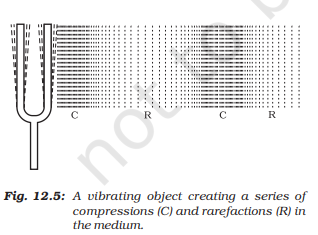Sound System 9th Class Course
We are all aware of the phenomenon of sound. From waking up in the morning to going to sleep at night, we hear sound all around us. Sound is a form of energy which produces a sensation of hearing in our ears.
Question: How can you
claim that sound is a form of energy?
We know that energy can neither be created nor be destroyed, it can only change forms. To create any kind of sound, energy is needed. Thus, some other form of energy is transformed into sound energy.
More precisely, sound is transmitted by vibrating molecules of air (or any other medium). Thus, sound energy can be thought of as a kind of kinetic energy.
Question: You must
have tried listening to the sound of upcoming train on the rails, even when the
train is not visible. Can you explain why this happens?
An interesting fact about sound is that it travels at different speeds in different mediums. This is because molecules are packed closer together in solids than in liquids or gases, so the vibrations travel much faster in solids. So, the sound of approaching train is transmitted faster trough the rails(solid) than in air(gas).
But how does sound travel? Well, let us consider a sound
producing source in air. This source needs to vibrate to produce vibrations in
the air molecules, and these vibrations travel through the air. Note that the
air molecules do not go from source to destination – they simply transfer the
vibration to the next molecule. The source creates regions of high and low
pressure in the air. The regions of high
pressure are called compressions, while those of low pressure are called
rarefactions.
Thus, propagation of sound can be visualized as propagation of density variations or pressure variations in the medium. It is important to note some key aspects of waves in order to understand sound waves further.
Simplified wave theory
A wave is a disturbance that can transfer energy. A wave is characterized by three aspects:
· Amplitude: This is a measure of how far the peak of the wave deviates from the mean position. In terms of sound, amplitude describes how loud the sound is.
· Frequency: This is how many times an object vibrates in a second. It is measured in Hertz (Hz). The human ear is said to be sensitive to sounds within a rough range of 20 – 20,000 Hz. A related concept is that of Time Period. The time taken by two consecutive compressions or rarefactions to cross a fixed point is called the time period of the wave.
Frequency and time period are inversely related, that is, fT = 1, where f is the frequency of vibration and T is the Time period of vibration. In terms of sound, high frequency means high pitch, and low frequency means low pitch.
· Phase: This has to do with how “shifted” a wave is with respect to a chosen origin. Phase becomes important when two or more sources are considered.
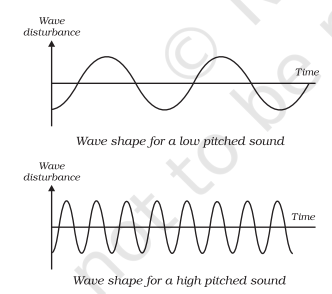
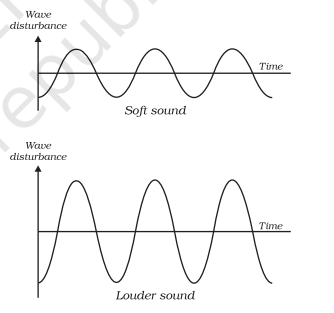
Wavelength is simply the distance between two peaks of a wave. It is denoted by Greek letter lambda(λ). Note that positive peaks are also called “crests”, while negative peaks are called “troughs”.

An important result to bear in mind is the relation between wave velocity, frequency and wavelength. It may be given as follows:
Wave velocity = wavelength × frequency.
In symbolic terms, the equation
may be written as v = fλ, where the symbols have their usual meanings.
Question: Is intensity the same as loudness?
The amount of sound energy passing each second through unit area is called the intensity of sound. We sometimes use the terms “loudness” and “intensity” interchangeably, but they are not the same. Loudness is a measure of the response of the ear to the sound. Even when two sounds are of equal intensity, we may hear one as louder than the other simply because our ear detects it better.
The Phenomena of Echo
You must have seen that when you shout at distant hills, you can hear your own voice. Or if you talk in a large empty room, you can also hear yourself. This is termed as “echo”.
Question: Why do we not hear echoes all the time, if sound is reflected
by most objects?
The sensation of sound persists in our brain for about 0.1 s. To hear a distinct echo the time interval between the original sound and the reflected one must be at least 0.1s. If we take the speed of sound to be 344 m/s at a given temperature, say at 22 ºC in air, the sound must go to the obstacle and reach back the ear of the listener on reflection after 0.1s. Hence, the total distance covered by the sound from the point of generation to the reflecting surface and back should be at least (344 m/s) × 0.1 s = 34.4 m. Thus, for hearing distinct echoes, the minimum distance of the obstacle from the source of sound must be half of this distance, that is, 17.2 m.
Question: Is the above-mentioned distance a constant?
No, this distance will change with the temperature of air.
Reverberation
A sound created in a big hall will persist by repeated reflection from the walls until it is reduced to a value where it is no longer audible. The repeated reflection that results in this persistence of sound is called reverberation. Halls and theaters are built in such a way to reduce reverberation.
Question: How can reverberation be reduced?
To reduce reverberation, the roof and walls of the hall are generally covered with sound-absorbent materials like compressed fiberboard, rough plaster or draperies. The seat materials are also selected on the basis of their sound absorbing properties.
Range of sound by frequency
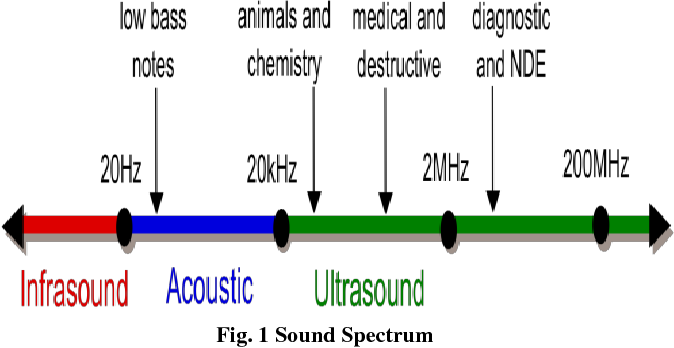
Humans are capable of hearing sounds in the range of 20 – 20kHz (kHz means kilohertz). Kids can usually hear up to 25 kHz. Sounds of frequencies below 20 Hz are called infrasonic sound or infrasound.Frequencies higher than 20 kHz are called ultrasonic sound or ultrasound. Ultrasound is produced by animals such as dolphins, bats and porpoises.
Ultrasounds are high frequency waves. Ultrasounds are able to travel along well-defined paths even in the presence of obstacles. Ultrasounds are used extensively in industries and for medical purposes. Following are some of its applications:
• Ultrasound is generally used to clean parts located in hard-to-reach places, for example, spiral tube, odd shaped parts, electronic components etc.
• Ultrasounds can be used to detect cracks and flaws in metal blocks.
• Ultrasonic waves are made to reflect from various parts of the heart and form the image of the heart. This technique is called ‘echocardiography’.
• Ultrasound scanner is an instrument which uses ultrasonic waves for getting images of internal organs of the human body.
SONAR
The acronym SONAR stands for SOund Navigation And Ranging. Sonar is a device that uses ultrasonic waves to measure the distance.
Question: How does SONAR work?
The transmitter produces and transmits ultrasonic waves. These waves travel through water and after striking the object on the seabed, get reflected back and are sensed by the detector. The detector converts the ultrasonic waves into electrical signals which are appropriately interpreted. The distance of the object that reflected the sound wave can be calculated by knowing the speed of sound in water and the time interval between transmission and reception of the ultrasound.
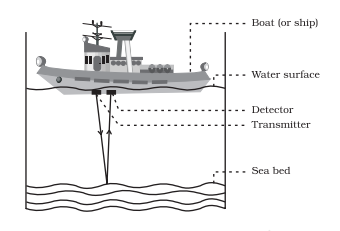
Similar uses of sound reflection are seen in animals. For example, bats search out prey and fly in dark night by emitting and detecting reflections of ultrasonic waves. The high-pitched ultrasonic squeaks of the bat are reflected from the obstacles or prey and returned to bat’s ear. The nature of reflections tells the bat where the obstacle or prey is and what it is like. Porpoises also use ultrasound for navigation and location of food in the dark.
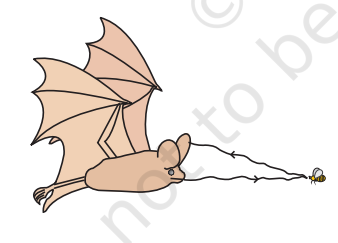
Summary
·
Sound is produced due to vibration of different
objects.
·
Sound travels as a longitudinal wave through a
material medium.
·
Sound travels as successive compressions and
rarefactions in the medium.
·
In sound propagation, it is the energy of the
sound that travels and not the particles of the medium.
·
Sound cannot travel in vacuum.
·
The change in density from one maximum value to
the minimum value and again to the maximum value makes one complete
oscillation.
·
The distance between two consecutive
compressions or two consecutive rarefactions is called the wavelength, λ.
·
The time taken by the wave for one complete
oscillation of the density or pressure of the medium is called the time period,
T.
·
The number of complete oscillations per unit
time is called the frequency(f), 1/f = T.
·
The speed v, frequency f, and wavelength λ, of
sound are related by the equation, v = λf.
·
The persistence of sound in an auditorium is the
result of repeated reflections of sound and is called reverberation.
·
Sound properties such as pitch, loudness and quality
are determined by the corresponding wave properties.
·
Sound waves with frequencies below the audible
range are termed “infrasonic” and those above the audible range are termed
“ultrasonic”.
·
Ultrasound has many medical and industrial
applications.
·
The SONAR technique is used to determine the
depth of the sea and to locate under water hills, valleys, submarines,
icebergs, sunken ships etc.
 Discuss
Discuss